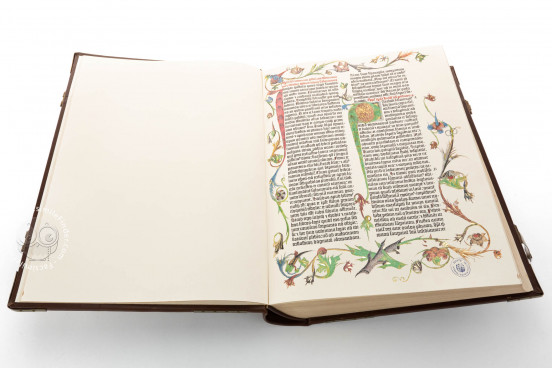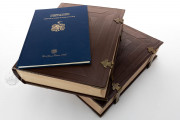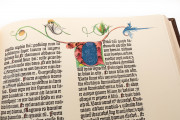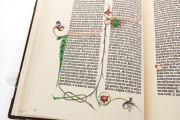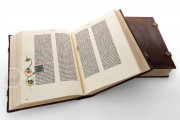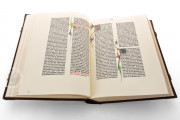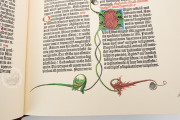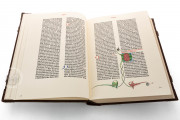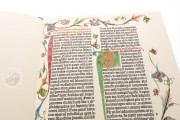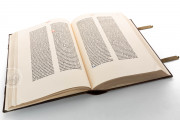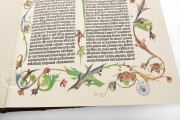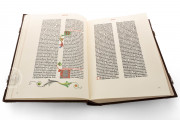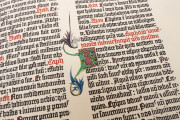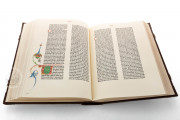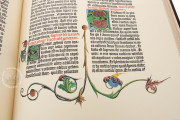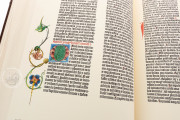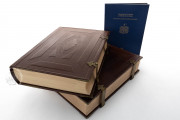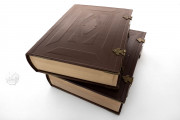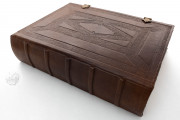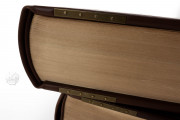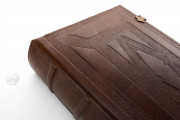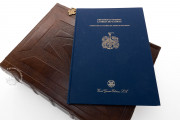The Burgos Gutenberg Bible, also known as the 42-lined Bible and held in the Burgos Public Library, is a remarkable historical treasure. Produced in Mainz, Germany, between 1452 and 1455, it consists of two volumes and is renowned as one of the earliest printed books using movable type. This edition holds great significance as it represents a groundbreaking milestone in the history of printing.
The text of this Bible is the Old and New Testament according to the Vulgate, a Latin version of the Scriptures by Saint Jerome, concluding with the Book of Revelation. Each page is meticulously composed of 42 lines of text, elegantly arranged in two columns, with elaborate initials hand-illuminated in red and blue ink, enhancing the visual appeal of the biblical text. The printing is uniform, and the composition is carefully executed, with appropriate spacing between letters and words. The typeface used is gothic, clean, and regular.
Customizable Illuminated Capitals
This particular copy of the Gutenberg Bible lacks foliation, epigraphs on the pages, and capital letters at the beginning of chapters. However, it does feature an "incipit" similar to manuscripts, appearing in red ink at the start of the Pentateuch and the Book of Genesis. The rest of the rubrics are handwritten, and the drawings' outlines allowed for manual coloring. Like other printed works of the time, this Bible reproduces the characteristics of manuscript books, leaving space for illuminated capitals at the start of words and initials according to the clients' willingness to pay. As a result, each copy is a unique piece, with no identical copies.
Delicate Strokes of Color
The most remarkable aspect of the Burgos 42-line Bible is its magnificent illumination, which was added later by a skilled artist. The abundant use of colors such as green, blue, yellow, and ochre gives it the appearance of a luxurious manuscript. The initials and flourishes have been delicately painted by a single hand, maintaining a consistent quality throughout both volumes. The chapter initials are executed in a single color, while the prologue and the remaining initials are painted with watercolors, showcasing a varied range of colors.
The second volume features "knotted sticks," which play a significant role in heraldry and bear the printer's mark of Fust and Schoffer. The most likely workshop responsible for this production is that of Fust, possibly with the involvement of an illuminator closely associated with him, known as "the painter of Fust." This artist arrived in Mainz from Austria, attracted by the challenge that the invention of printing posed for illuminators.
A Generous Donation
Luis de Maluenda was a prominent figure in fifteenth-century Burgos and a relative of the Santamaría family. He was indeed the grandson of María Nuñez, sister of Bishop Pablo Santamaría of Burgos and the chronicler of Juan II, Alvar García de Santamaría. In his testament, dated September 23, 1488, Maluenda generously bequeathed the Bible to the Monastery of San Juan de Ortega, ensuring its preservation. Luis de Maluenda's familial ties and his ecclesiastical position as a canon and later as a treasurer and chief chaplain at the Cathedral of Burgos provided him with a privileged connection to the Gutenberg Bible. Following the secularization of the monastery in the nineteenth century, the Gutenberg Bible found its way to the Burgos Public Library.
We have 1 facsimile edition of the manuscript "Burgos Gutenberg Bible": Gutenberg's Bible or The 42 Lined Bible facsimile edition, published by Vicent Garcia Editores, 1995
Request Info / Price
